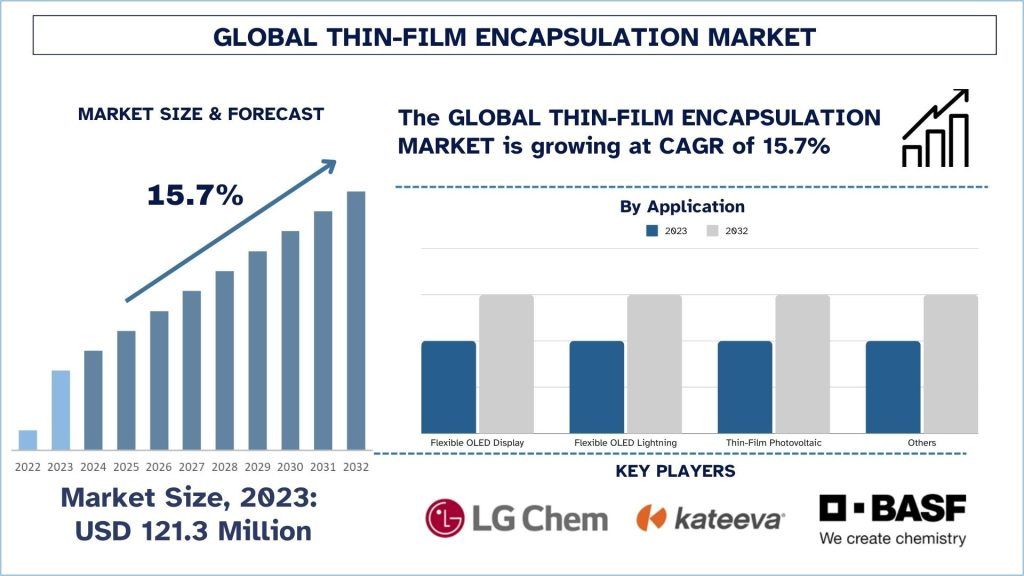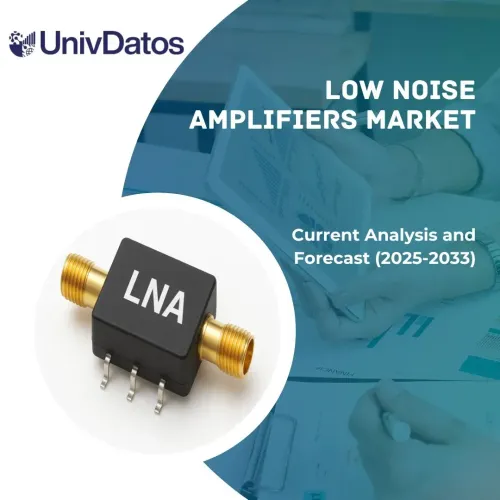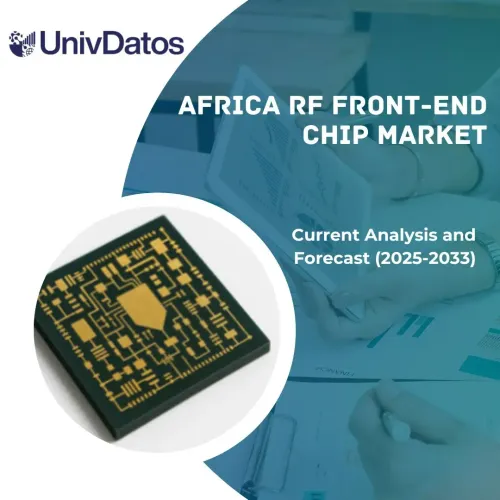- Inicio
- Acerca de nosotros
- Industria
- Servicios
- Leyendo
- Contáctenos
Mercado de encapsulación de película delgada: análisis actual y previsión (2024-2032)
Énfasis en el tipo (capa inorgánica y capa orgánica); aplicación (pantalla OLED flexible, iluminación OLED flexible, celda fotovoltaica de película delgada y otros); región/país.
Tamaño del mercado y previsión de la encapsulación de película delgada
El mercado de la encapsulación de película delgada se valoró en 121,3 millones de dólares en 2023 y se espera que crezca a una fuerte CAGR de alrededor del 15,7% durante el período de previsión (2024-2032) debido al creciente uso en las empresas de electrónica de consumo y solares.
Análisis del mercado de la encapsulación de película delgada
El mercado de la encapsulación de película delgada (TFE) es vital en la evolución de la próxima generación, la electrónica flexible, incluyendo la pantalla OLED, los fotovoltaicos orgánicos (OPV) y la electrónica portátil. La tecnología TFE significa que se pueden utilizar capas delgadas flexibles para proteger las partes vulnerables de la electrónica de la humedad y el oxígeno, lo que mejora su tiempo medio entre fallos y su rendimiento. El mercado está impulsado principalmente por la mayor demanda de pantallas OLED flexibles, que se utilizan ampliamente para teléfonos inteligentes, tabletas, aparatos plegables y otros productos electrónicos. El evidente avance en la electrónica flexible y la electrónica portátil, y especialmente en las regiones emergentes de América del Norte, Asia-Pacífico y Europa, ha aumentado la necesidad de mejores soluciones de encapsulación. Además, el desarrollo dinámico de las tecnologías de deposición multicapa y la creciente popularidad de los productos inteligentes contribuyen al crecimiento del mercado de las soluciones TFE.
Proyecciones futuras del crecimiento del mercado de TFE Se espera que la región de Asia-Pacífico en concreto, China y Japón, sean actores clave en el mercado de TFE debido a su posición de liderazgo en la industria de las pantallas OLED. Por lo tanto, las estrategias gubernamentales como la de China Made in China 2025 están promoviendo la inversión en la producción de OLED y electrónica flexible y, en consecuencia, aumentando la necesidad de TFE. Además, la India lanzó el plan de incentivos vinculados a la producción (PLI) en 2021 para las industrias de fabricación de semiconductores y pantallas, por lo que es probable que el país se convierta en un lugar ideal para las industrias de TFE. Se cree que estos factores gubernamentales, junto con la mayor demanda de electrónica de nueva generación, impulsarán el mercado de TFE con el dominio de APAC en el mercado.
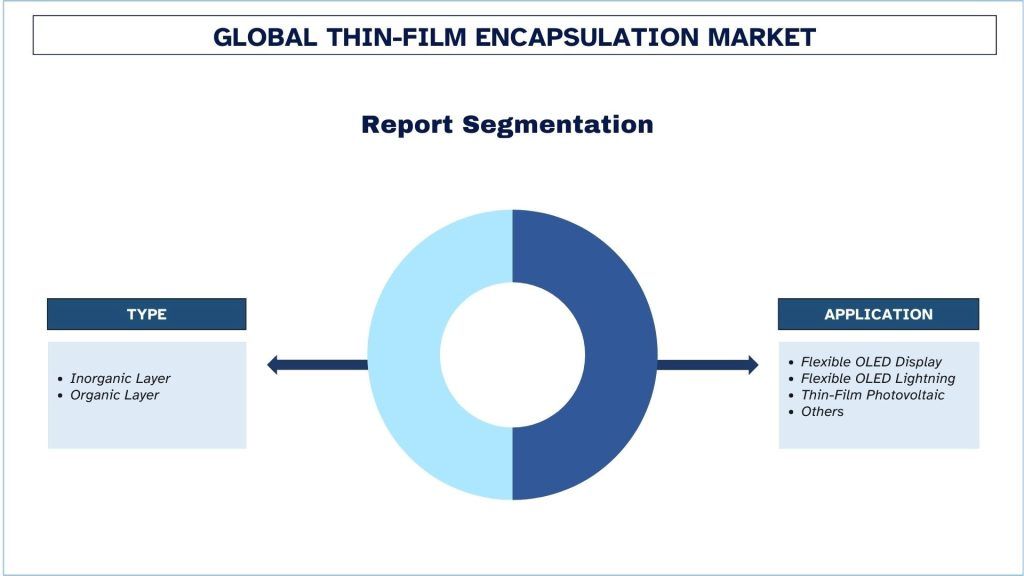
Tendencias del mercado de la encapsulación de película delgada
En esta sección se analizan las principales tendencias del mercado que están influyendo en los distintos segmentos del mercado de la encapsulación de película delgada, según lo identificado por nuestro equipo de expertos en investigación.
Creciente demanda de pantallas OLED flexibles
El uso de pantallas OLED flexibles se está expandiendo gradualmente en prácticamente todas las categorías de electrónica de consumo, incluyendo los teléfonos inteligentes, las tabletas, los dispositivos plegables y la tecnología portátil. La necesidad de pantallas OLED es el resultado de la mejor calidad de visualización, la eficiencia y la posibilidad de producir dispositivos más delgados que las pantallas LCD convencionales. Sin embargo, los materiales OLED tienen una sensibilidad muy alta a la humedad y al oxígeno, lo que perjudica el rendimiento de la pantalla OLED y acorta su vida útil. La encapsulación de película delgada es una salvaguardia que tiene la capacidad de proteger las pantallas OLED de todos los factores adversos del entorno y, por lo tanto, puede considerarse de gran importancia en lo que respecta a la durabilidad y el rendimiento de los dispositivos. Estos problemas son particularmente importantes debido al creciente uso de OLED flexibles para dispositivos móviles que pueden utilizarse en cualquier lugar, lo que hace que la necesidad de una encapsulación adecuada se expanda rápidamente a medida que más fabricantes integran OLED flexibles en sus productos.
Ejemplo: Uno de los teléfonos inteligentes que utiliza la flexibilidad de las pantallas OLED es el Samsung Galaxy Fold, un teléfono inteligente con una solución de plegado. En cuanto a estas pantallas, cabe señalar que son bastante sensibles a la humedad y al oxígeno. La encapsulación de película delgada tiene el propósito significativo de proteger la capa OLED súper delgada de los efectos indeseables del medio ambiente, lo que hace que el dispositivo sea flexible, duradero y proporciona una pantalla de alta calidad.
Crecimiento de la tecnología portátil
Los relojes inteligentes, los rastreadores de actividad física y los dispositivos de control de la salud se encuentran entre los dispositivos portátiles más solicitados que han crecido hasta convertirse en un mercado lucrativo en el mercado internacional. Debido a la construcción física de dichos dispositivos y la forma en que se utilizan, estos requieren pantallas que sean ligeras, delgadas y robustas. La encapsulación de película delgada tiene un papel fundamental en la fabricación de dispositivos portátiles porque asegura las partes electrónicas flexibles de los efectos adversos de la humedad, el sudor, la flexibilidad y la presión mecánica, que son características típicas de los dispositivos portátiles. La innovación continua y la implementación de dispositivos portátiles, particularmente en los sectores de la salud y el estado físico, son las razones clave que están aumentando la necesidad de técnicas de encapsulación más mejoradas que son muy vitales para garantizar la durabilidad y la eficacia del dispositivo.
Ejemplo: El reloj inteligente Apple es otra innovación tecnológica de Apple, y este es un reloj inteligente que utiliza pantallas OLED flexibles para su tamaño compacto. Muchos de estos dispositivos portátiles están en contacto con la humedad, el sudor y el estrés mecánico durante el proceso de uso. La TFE se emplea para sellar la pantalla OLED y la electrónica interna contra la intrusión de agua y oxígeno, lo que mejora la durabilidad y la funcionalidad del dispositivo. Por lo tanto, la encapsulación es importante para proporcionar al Apple Watch la impermeabilización y la funcionalidad necesarias en estas diferentes condiciones de uso que son importantes antes de que pueda ocurrir el seguimiento del estado físico y la salud.
Mayor adopción de fotovoltaica de película delgada
La fotovoltaica de película delgada o TFPV está surgiendo gradualmente como una opción popular debido a su costo relativamente bajo y su peso ligero en comparación con los paneles solares de silicio convencionales. Estas células solares se aplican en sistemas BIPV, sistemas solares de cargadores portátiles y en sistemas de energía solar. Sin embargo, las células solares de película delgada tienen algunas desventajas robustas que incluyen la sensibilidad a la humedad, el oxígeno y la luz UV, que afectan la eficiencia y la durabilidad de la célula. La encapsulación de película delgada propone una capa de protección que mejora la durabilidad y la funcionalidad de estas células solares en condiciones ambientales severas. Dado que el segmento de las energías renovables es uno de los que se está expandiendo rápidamente, especialmente a la luz de la integración de políticas sostenibles en todo el mundo, se espera que el uso de TFE en la fotovoltaica de película delgada aumente exponencialmente en el futuro.
Ejemplo: First Solar, un fabricante de paneles solares de película delgada, emplea la tecnología CdTe para proporcionar módulos solares de alta eficiencia y bajo costo. La encapsulación de película delgada es más apropiada, ya que protege estas células fotovoltaicas de la humedad y el oxígeno, que son destructivos para las células. Al encapsular las células solares, First Solar puede garantizar que sus módulos de película delgada funcionarán de manera óptima en casi cualquier ubicación y condición climática, ya que el calor puede ser fatal para un módulo de células solares y la humedad afecta el rendimiento del panel solar en un gran proyecto energético.
Se espera que APAC crezca con una CAGR significativa durante el período de pronóstico
El mercado de encapsulación de película delgada (TFE) en Asia-Pacífico (APAC) está creciendo rápidamente con China y Japón liderando la región debido a la creciente inversión en tecnología OLED y la floreciente industria de fabricación de electrónica. China, especialmente, ha invertido fuertemente en la producción de OLED y tiene demandas internas de pantallas flexibles que se utilizan ampliamente en teléfonos inteligentes y televisores. Japón sigue siendo una de las principales naciones en el campo de la I+D e innovaciones en diversas industrias, en particular la industria OLED y su aplicación a la electrónica de consumo y la industria automotriz. India también está emergiendo como un mercado fundamental debido a su cambio de enfoque en la fabricación nacional a través de su programa "Make in India", que también puede apoyar la fabricación de pantallas OLED y otros productos electrónicos flexibles.
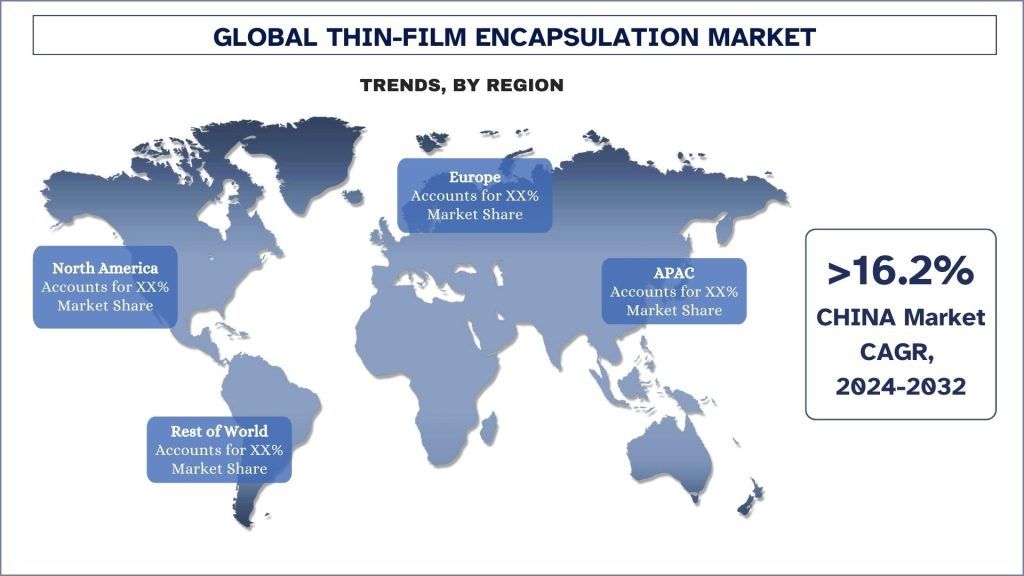
Descripción general de la industria de encapsulación de película delgada
El mercado de encapsulación de película delgada es competitivo y está fragmentado, con la presencia de varios actores del mercado global e internacional. Los principales actores están adoptando diferentes estrategias de crecimiento para mejorar su presencia en el mercado, como asociaciones, acuerdos, colaboraciones, lanzamientos de nuevos productos, expansiones geográficas y fusiones y adquisiciones. Algunos de los principales actores que operan en el mercado incluyen Samsung SDI, LG Chem, Universal Display Corp. (UDC), Applied Materials Inc., Veeco Instruments Inc., 3M, Toray Industries Inc., Kateeva, BASF AG y Meyer Burger Technology Limited.
Noticias del mercado de encapsulación de película delgada
El fabricante de micropantallas microOLED ha recibido equipos de inyección de tinta para Sidtek de la firma de impresión de inyección de tinta de Unijet. El equipo está previsto que sea empleado en la producción de pantallas microOLED por la empresa china.
En abril de 2023, LG Display comenzó a desarrollar una nueva tecnología de grabado para paneles OLED que se suministrará a Apple. La compañía está preparando la tecnología para lanzar un llamado panel OLED híbrido, que utiliza un sustrato de vidrio como un panel OLED rígido, pero utiliza encapsulación de película delgada (TFE) como la de un panel OLED flexible. Los paneles OLED rígidos convencionales utilizaban dos sustratos de vidrio, pero en un panel OLED híbrido, el sustrato de vidrio superior se reemplaza con TFE.
Cobertura del informe del mercado de encapsulación de película delgada
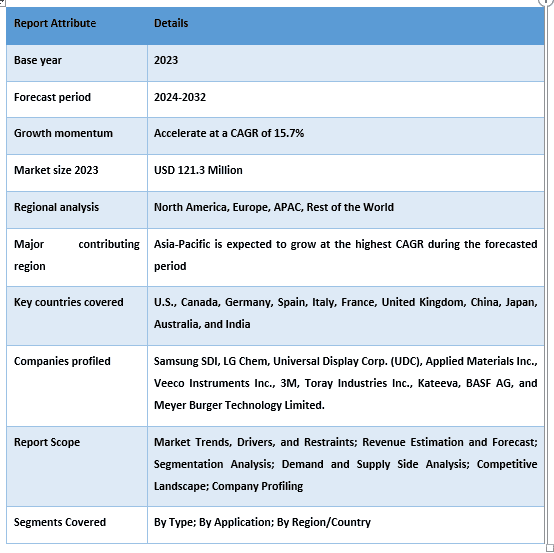
Razones para comprar este informe:
- El estudio incluye el dimensionamiento del mercado y el análisis de las previsiones validados por expertos clave autenticados de la industria.
- El informe presenta una revisión rápida del rendimiento general de la industria de un vistazo.
- El informe cubre un análisis en profundidad de los principales pares de la industria con un enfoque principal en las finanzas comerciales clave, las carteras de productos, las estrategias de expansión y los desarrollos recientes.
- Examen detallado de los impulsores, las restricciones, las tendencias clave y las oportunidades que prevalecen en la industria.
- El estudio cubre de forma exhaustiva el mercado en diferentes segmentos.
- Análisis profundo a nivel regional de la industria.
Opciones de personalización:
El mercado global de encapsulación de película delgada se puede personalizar aún más según los requisitos o cualquier otro segmento de mercado. Además de esto, UMI entiende que puede tener sus propias necesidades comerciales, por lo tanto, no dude en contactarnos para obtener un informe que se adapte completamente a sus requisitos.
Tabla de contenido
Metodología de Investigación para el Análisis del Mercado de Encapsulado de Película Delgada (2024-2032)
El análisis del mercado histórico, la estimación del mercado actual y la previsión del mercado futuro del Encapsulado de Película Delgada global fueron los tres pasos principales que se llevaron a cabo para crear y explorar la adopción del Encapsulado de Película Delgada en las principales regiones a nivel mundial. Se llevó a cabo una exhaustiva investigación secundaria para recopilar las cifras históricas del mercado y estimar el tamaño actual del mercado. En segundo lugar, se tomaron en consideración numerosos hallazgos y supuestos para validar estas perspectivas. Además, también se realizaron exhaustivas entrevistas primarias con expertos de la industria en toda la cadena de valor del mercado global de Encapsulado de Película Delgada. Después de la suposición y la validación de las cifras del mercado a través de entrevistas primarias, empleamos un enfoque de arriba hacia abajo/de abajo hacia arriba para pronosticar el tamaño completo del mercado. Posteriormente, se adoptaron métodos de desglose del mercado y triangulación de datos para estimar y analizar el tamaño del mercado de los segmentos y subsegmentos de la industria. La metodología detallada se explica a continuación:
Análisis del Tamaño Histórico del Mercado
Paso 1: Estudio Profundo de Fuentes Secundarias:
Se realizó un estudio secundario detallado para obtener el tamaño histórico del mercado de Encapsulado de Película Delgada a través de fuentes internas de la empresa, como informes anuales y estados financieros, presentaciones de rendimiento, comunicados de prensa, etc., y fuentes externas, incluidos diarios, noticias y artículos, publicaciones gubernamentales, publicaciones de la competencia, informes del sector, bases de datos de terceros y otras publicaciones creíbles.
Paso 2: Segmentación del Mercado:
Después de obtener el tamaño histórico del mercado de Encapsulado de Película Delgada, realizamos un análisis secundario detallado para recopilar información histórica del mercado y compartirla para diferentes segmentos y subsegmentos para las principales regiones. Los principales segmentos se incluyen en el informe, como Tipo y Aplicación. Además, se llevaron a cabo análisis a nivel de país para evaluar la adopción general de modelos de prueba en esa región.
Paso 3: Análisis de Factores:
Después de adquirir el tamaño histórico del mercado de diferentes segmentos y subsegmentos, realizamos un análisis de factores detallado para estimar el tamaño actual del mercado de Encapsulado de Película Delgada. Además, realizamos un análisis de factores utilizando variables dependientes e independientes como Tipo y Aplicación del mercado de Encapsulado de Película Delgada. Se llevó a cabo un análisis exhaustivo de los escenarios de oferta y demanda teniendo en cuenta las principales asociaciones, fusiones y adquisiciones, expansión comercial y lanzamientos de productos en el sector de Encapsulado de Película Delgada en todo el mundo.
Estimación y Previsión del Tamaño Actual del Mercado
Tamaño actual del mercado: Basándonos en información práctica de los 3 pasos anteriores, llegamos al tamaño actual del mercado, los actores clave en el mercado global de Encapsulado de Película Delgada y las cuotas de mercado de los segmentos. Todos los porcentajes requeridos de participación, división y desglose del mercado se determinaron utilizando el enfoque secundario mencionado anteriormente y se verificaron a través de entrevistas primarias.
Estimación y previsión: Para la estimación y previsión del mercado, se asignaron ponderaciones a diferentes factores, incluidos los impulsores y las tendencias, las restricciones y las oportunidades disponibles para las partes interesadas. Después de analizar estos factores, se aplicaron técnicas de previsión relevantes, es decir, el enfoque de arriba hacia abajo/de abajo hacia arriba, para llegar a la previsión del mercado para 2032 para diferentes segmentos y subsegmentos en los principales mercados a nivel mundial. La metodología de investigación adoptada para estimar el tamaño del mercado abarca:
El tamaño del mercado de la industria, en términos de ingresos (USD) y la tasa de adopción del Encapsulado de Película Delgada en los principales mercados a nivel nacional.
Todos los porcentajes de participación, divisiones y desgloses de los segmentos y subsegmentos del mercado
Actores clave en el mercado global de Encapsulado de Película Delgada en términos de productos ofrecidos. Además, las estrategias de crecimiento adoptadas por estos actores para competir en el mercado de rápido crecimiento.
Validación del Tamaño y la Cuota de Mercado
Investigación Primaria: Se realizaron entrevistas en profundidad con los Líderes de Opinión Clave (KOL) que incluyen Ejecutivos de Alto Nivel (CXO/VP, Jefe de Ventas, Jefe de Marketing, Jefe de Operaciones, Jefe Regional, Jefe de País, etc.) en las principales regiones. Los hallazgos de la investigación primaria se resumieron y se realizó un análisis estadístico para probar la hipótesis establecida. Las aportaciones de la investigación primaria se consolidaron con los hallazgos secundarios, convirtiendo así la información en información práctica.
División de los Participantes Primarios en Diferentes Regiones
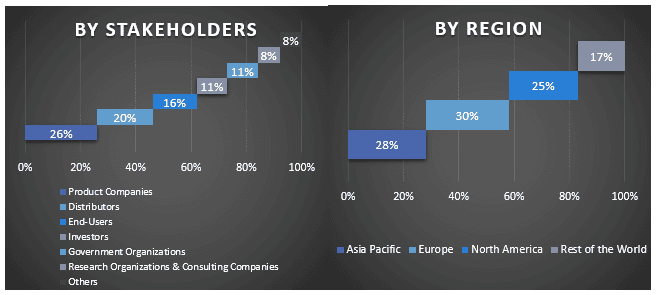
Ingeniería del Mercado
Se empleó la técnica de triangulación de datos para completar la estimación general del mercado y para llegar a números estadísticos precisos para cada segmento y subsegmento del mercado global de Encapsulado de Película Delgada. Los datos se dividieron en varios segmentos y subsegmentos después de estudiar varios parámetros y tendencias en las áreas de Tipo y Aplicación en el mercado global de Encapsulado de Película Delgada.
El objetivo principal del Estudio del Mercado Global de Encapsulado de Película Delgada
Las tendencias actuales y futuras del mercado global de Encapsulado de Película Delgada se identificaron en el estudio. Los inversores pueden obtener información estratégica para basar su criterio para las inversiones en el análisis cualitativo y cuantitativo realizado en el estudio. Las tendencias actuales y futuras del mercado determinaron el atractivo general del mercado a nivel regional, proporcionando una plataforma para que el participante industrial explote el mercado sin explotar para beneficiarse de una ventaja de ser el primero en actuar. Otros objetivos cuantitativos de los estudios incluyen:
- Analizar el tamaño actual y previsto del mercado de la industria de Encapsulado de Película Delgada en términos de valor (USD). Además, analizar el tamaño actual y previsto del mercado de diferentes segmentos y subsegmentos.
- Los segmentos en el estudio incluyen áreas de Tipo y Aplicación.
- Definir y analizar el marco regulatorio para la industria de Encapsulado de Película Delgada.
- Analizar la cadena de valor involucrada con la presencia de varios intermediarios, junto con el análisis de los comportamientos de clientes y competidores de la industria.
- Analizar el tamaño actual y previsto del mercado del mercado de Encapsulado de Película Delgada para la región principal.
- Los principales países de las regiones estudiadas en el informe incluyen Asia Pacífico, Europa, América del Norte y el Resto del Mundo.
- Perfiles de empresas del mercado de Encapsulado de Película Delgada y las estrategias de crecimiento adoptadas por los participantes del mercado para mantenerse en el mercado de rápido crecimiento.
- Análisis regional profundo de la industria.
Preguntas frecuentes Preguntas frecuentes
P1: ¿Cuál es el tamaño actual del mercado y el potencial de crecimiento del mercado de encapsulación de película delgada?
P2: ¿Cuáles son los factores impulsores del crecimiento del mercado de encapsulación de película delgada?
P3: ¿Qué segmento tiene la mayor cuota en el mercado de encapsulación de película delgada por aplicación?
P4: ¿Cuáles son las tecnologías y tendencias emergentes en el mercado de la encapsulación de película delgada?
P5: ¿Qué región dominará el mercado de encapsulación de película delgada?
Relacionados Informes
Los clientes que compraron este artículo también compraron

